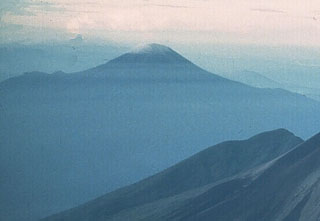Report on Bamus (Papua New Guinea) — February 1990
Bulletin of the Global Volcanism Network, vol. 15, no. 2 (February 1990)
Managing Editor: Lindsay McClelland.
Bamus (Papua New Guinea) Strong seismicity along a NNE-trending zone; two magnitude 5.0 events
Please cite this report as:
Global Volcanism Program, 1990. Report on Bamus (Papua New Guinea) (McClelland, L., ed.). Bulletin of the Global Volcanism Network, 15:2. Smithsonian Institution. https://doi.org/10.5479/si.GVP.BGVN199002-252110
Bamus
Papua New Guinea
5.2°S, 151.23°E; summit elev. 2248 m
All times are local (unless otherwise noted)
"Strong seismicity took place near Bamus during February. The seismicity started on the 2nd when almost 100 events were recorded (maximum ML 5.8 [but see 15:3]). In the following days the activity waned, but began to increase on the 8th. Seismicity peaked between the 10th and the 15th, when ~1,400 events were recorded, including three earthquakes of M 5.8-6.0. Activity declined irregularly during the following 10 days, but began increasing again on the 25th. During the second peak of activity, between the 25th and the 28th, ~880 events were recorded including two earthquakes of M 5.0. Activity declined again at the end of the month.
"Inspections of Bamus were carried out on 13 and 16 February. Rockfalls had occurred at many places on the volcano, apparently associated with the seismicity. Temperatures in solfataric areas on the summit tholoid remained low (<15°C) however. A temporary seismograph network, operated in the area between 13 and 16 February, enabled locations of some earthquakes to be calculated. Epicenters were distributed in a 10-km-long NNE-trending zone that included the S flanks of Bamus. Focal depths ranged between 0 and 23 km. The seismicity was continuing in early March and was being monitored primarily by the permanent seismograph at Ulawun Volcano."
Geological Summary. Symmetrical Bamus volcano, also referred to locally as the South Son, is located SW of Ulawun volcano, known as the Father. The andesitic stratovolcano is covered in rainforest and contains a breached summit crater filled with a lava dome. There is a cone on the southern flank, and a prominent 1.5-km-wide crater with two small adjacent cones halfway up the SE flank. Young pyroclastic-flow deposits are found on the flanks, and residents describe an eruption that took place during the late 19th century.
Information Contacts: C. McKee, RVO.

